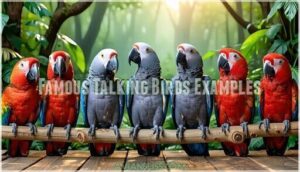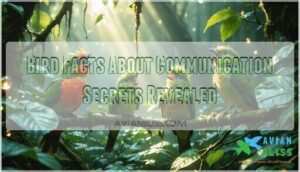This site is supported by our readers. We may earn a commission, at no cost to you, if you purchase through links.

These feathered linguists can master hundreds of words and actually use them in context, not just mindlessly repeat sounds.
Amazon parrots, Hill Mynas, and even some clever corvids like ravens also demonstrate impressive speech abilities.
What makes these birds such gifted talkers isn’t just their specialized vocal anatomy—it’s their high intelligence and natural learning capabilities that allow them to understand meaning behind words.
Some species can even create their own word combinations and respond appropriately to questions, turning simple mimicry into genuine communication.
They can use their abilities to understand and replicate human speech in a way that is both impressive and useful for interacting with their environment.
Table Of Contents
- Key Takeaways
- Birds Mimic Human Speech
- Top Talking Bird Species
- Factors Influencing Mimicry
- Training Birds to Talk
- Famous Talking Birds Examples
- Frequently Asked Questions (FAQs)
- Which bird can be trained to speak like humans?
- Can birds actually talk or just mimic?
- Which bird is known for its ability to imitate human speech?
- Can love birds mimic human speech?
- What are the challenges of bird mimicry?
- Can wild birds learn to mimic speech?
- How does diet impact vocal mimicry abilities?
- Are female birds less likely to mimic speech?
- Which bird species are easiest for beginners?
- Can birds mimic regional accents or dialects?
- Conclusion
Key Takeaways
- African Grey parrots top the list with their ability to master 1,000+ words and use them in context – they don’t just repeat sounds but actually understand meaning and respond appropriately to conversations.
- Intelligence drives mimicry more than anatomy – birds with higher cognitive abilities like Amazon parrots, Hill Mynas, and some corvids can learn speech because they possess advanced learning capabilities and specialized brain structures.
- Training success depends on social bonding and consistent practice – you’ll get better results when you spend quality time interacting with your bird daily, using positive reinforcement and repetition during focused training sessions.
- Early exposure and environment matter significantly – young birds absorb sounds during critical development periods, so consistent human conversation and varied audio experiences create the foundation for impressive vocal abilities.
Birds Mimic Human Speech
You’ll discover that several remarkable bird species possess the extraordinary ability to mimic human speech with stunning accuracy.
These feathered linguists use their specialized vocal organs and advanced cognitive abilities to replicate words, phrases, and even entire conversations, showcasing their extraordinary ability.
African Grey Parrot Abilities
In terms of vocal clarity and cognitive skills, the African Grey Parrot reigns supreme in the bird world.
These remarkable creatures don’t just mimic—they communicate with purpose and understanding.
These feathered geniuses don’t just copy sounds—they understand context and respond with genuine intelligence.
Your Grey’s intelligence levels rival those of a young child, making their mimicry skills truly extraordinary.
Unlike simple repetition, they demonstrate genuine vocal learning through contextual responses and emotional awareness.
What sets African Grey parrot mimicry apart:
- Vocabulary reaching 1,000+ words with crystal-clear speech patterns
- Contextual understanding allowing appropriate conversational responses
- Emotional depth shown through varied tones and situational awareness
- Problem-solving abilities matching 5-year-old children.
Their advanced mimicry techniques transform simple sounds into meaningful bird language.
These feathered linguists will surprise you with witty comebacks that showcase their remarkable ability to process and respond to human communication with stunning accuracy.
Amazon Parrot Mimicry
Amazon Parrots showcase remarkable vocal clarity that rivals human speech patterns. You’ll discover their mimicry skills develop through dedicated practice, with Yellow-naped Amazons often mastering 50+ words through consistent vocal learning.
Amazon intelligence shines through purposeful parrot communication—they don’t just repeat sounds mindlessly. These Amazon parrots adapt their bird language based on social situations and emotional context.
Their advanced parrot mimicry stems from sophisticated syrinx control, allowing precise sound modulation. Individual personalities dramatically influence learning pace, with some birds becoming chatty companions while others remain selective speakers.
Geographic location affects their vocalizations, creating unique regional "accents" within species.
Hill Myna Speech Replication
Throughout South and Southeast Asia, Hill Mynas reign as nature’s most sophisticated vocal mimics. You’ll discover their mimic human speech abilities surpass most parrots through advanced avian vocalization systems.
Their remarkable speech imitation stems from three key factors:
- Vocal learning pathways mirroring human neural development
- Bird intelligence rivaling corvids in cognitive complexity
- Specialized syrinx enabling precise vocal mimicry
These mimicry skills allow Hill Mynas to replicate entire conversations with startling accuracy, making their Myna vocalization virtually indistinguishable from human speakers. The study of bird vocalizations revealed provides valuable insights into the nuances of their speech replication abilities.
Top Talking Bird Species
Several parrot species showcase remarkable parrot intelligence and mimicry skills that’ll blow your mind.
African Grey Parrots lead the pack with their massive vocabulary and context-aware responses – they’re basically feathered Einstein’s.
Amazon Parrots charm you with crystal-clear speech patterns and cheerful personalities, while tiny Budgerigars prove size doesn’t limit avian cognition.
Hill Mynas replicate human bird vocalization so perfectly it’s almost eerie.
Don’t overlook Indian Ringneck Parakeets and Eclectus Parrots – these talking birds surprise owners with witty comebacks and engaging conversations that demonstrate how well birds can mimic human speech.
Understanding bird species with unique calls is essential for appreciating the complexity of avian communication and behavior, as seen in bird call variations.
Factors Influencing Mimicry
You’ll discover that several key factors determine whether a bird can master human speech mimicry.
Intelligence levels, brain structure, social bonds, and early exposure all play vital roles in developing these remarkable vocal abilities, including intelligence levels and social bonds.
Intelligence and Vocal Abilities
Behind every talking bird’s impressive vocal learning lies extraordinary cognitive abilities and specialized brain structure.
Every talking bird’s remarkable mimicry stems from extraordinary intelligence and specialized neural architecture.
These feathered linguists possess avian intelligence comparable to young children, enabling complex speech patterns through dedicated mimicry training.
The ability to mimic sounds is linked to advanced vocal learning processes.
- African Grey parrots demonstrate cognitive abilities matching 5-year-old children in problem-solving tasks
- Parrot mimicry relies on unique "shell" brain regions absent in other bird species
- Vocal learning pathways involve specialized neurons responding to consonants and vowels distinctly
- Mimicry skills develop through advanced syrinx control and muscular tongue manipulation
- Speech patterns emerge from auditory sensitivity perfectly aligned with human frequency ranges
Social Interaction and Bonding
Your feathered friend’s social interaction with you becomes the secret ingredient for developing impressive vocal learning abilities.
When you spend quality time chatting, playing, and bonding with your bird companions, you’re strengthening emotional bonds that directly fuel their parrot mimicry skills.
This social learning process works because birds naturally want to communicate with their flock—and that’s you!
Interactive play sessions and consistent relationship building activities create the perfect environment for bird social behavior to flourish.
The stronger your birdhuman interaction, the more motivated your parrot becomes to master human speech patterns and join your conversations.
Brain Structure and Vocal Learning
Social connections matter, but your bird’s brain anatomy makes mimicry truly possible.
The specialized vocal learning pathways in talking birds reveal incredible neural connections that rival human speech systems.
You’ll find these remarkable features in vocal learning species:
- Syrinx Function: This unique vocal organ allows birds to produce multiple sounds simultaneously, unlike human vocal cords
- Vocal Pathways: Seven specialized brain nuclei form organized circuits for learning and producing vocalizations
- Brain Anatomy: Anterior and posterior neural groups work together, creating feedback loops for vocal modification
- Neural Connections: Direct links between vocal regions and motor control areas enable precise sound timing
- Cognitive Development: Enhanced forebrain structures support continuous vocal learning throughout life
The syrinx’s sophisticated structure, combined with specialized vocal learning pathways, creates nature’s most advanced mimicry system.
Bird cognitive skills develop through these neural networks, allowing mimicry evolution to flourish in species like parrots and mynas.
Researchers study vocal learning mechanisms to understand how birds achieve complex vocalizations.
Environmental Exposure and Learning
Environmental exposure shapes a bird’s vocal learning journey more than you might expect.
Young birds absorb environmental sounds during critical development periods, building their mimicry evolution foundation.
Social exposure to human conversation creates rich auditory learning opportunities, while sound imitation skills flourish through diverse vocal stimulation.
Environmental enrichment with varied audio experiences strengthens learning patterns, transforming basic vocal mimicry abilities into sophisticated communication tools that amaze bird enthusiasts worldwide.
Training Birds to Talk
Training your feathered companion to mimic human speech requires patience, consistency, and the right approach.
You’ll find success comes from understanding your bird’s natural learning abilities and creating an environment that encourages vocal development.
Training Birds to Talk Introduction
Training your feathered companion to mimic human speech requires patience, consistency, and the right approach.
You’ll find success comes from understanding your bird’s natural learning abilities and creating an environment that encourages vocal development.
Positive Reinforcement Techniques
Three powerful reward systems can transform your parrot into a chatty companion. Operant conditioning works best when you reward vocal attempts immediately with high-value treats like sunflower seeds or enthusiastic praise.
Clicker training provides precise timing for vocal shaping:
- Click the moment your bird attempts speech imitation or mimicry
- Follow each click with treats to reinforce vocal learning behaviors
- Use mimicry games that combine visual targets with verbal cues
This positive reinforcement approach builds trust while accelerating parrot training. Your feathered friend will enthusiastically participate in training sessions, viewing them as enjoyable social interactions rather than work.
Understanding bird communication methods is essential for effective parrot training and fostering a deeper connection with your bird.
Repetition and Consistency
Beyond simple word drills, you’ll create lasting vocal learning through structured Mimicry Exercises.
Daily Vocal Practice sessions using Consistent Training schedules help establish reliable Speech Patterns.
Your bird’s neural pathways strengthen when you repeat target words with identical tone during focused sessions.
Learning Techniques that emphasize repetition and speech imitation build natural mimicry skills over time.
This methodical approach to parrot talk transforms mechanical copying into meaningful communication through persistent, patient practice sessions.
Effective training also relies on utilizing proper parrot training tools to support the learning process, which is a key part of Consistent Training and helps in developing reliable Speech Patterns through persistent efforts.
Individual Personality and Species Traits
Each bird’s personality fingerprint shapes its vocal journey differently.
Your parrot intelligence and bird temperament create unique learning paths that require customized approaches.
Consider these personality types and species traits:
- Bold explorers like Amazon Parrots embrace new words enthusiastically, thriving on social interaction and vocal learning challenges
- Cautious observers such as Indian Ringneck Parakeets need patient, gentle encouragement to develop their vocal abilities
- Natural performers including Hill Mynas effortlessly mimic human speech through their inherent avian communication skills
Understanding your bird’s individual species traits helps you customize training methods, making bird mimicry sessions more effective and enjoyable for both you and your feathered companion.
Effective training also relies on using proper parrot training techniques to enhance the learning experience.
Providing Proper Care and Enrichment
Proper parrot care creates the foundation for successful vocal learning. You’ll need Diet Planning with fresh fruits, vegetables, and high-quality pellets to support brain development.
Cage Enrichment through rotating toys and foraging opportunities prevents boredom while encouraging Social Stimulation. Daily Social Interaction builds trust essential for bird training.
Consider Noise Reduction during rest periods and schedule regular Veterinary Care to maintain prime health. This thorough bird stimulation approach guarantees your feathered friend stays mentally sharp and motivated to mimic human speech.
A well-balanced parrot diet includes access to parrot food options that cater to their nutritional needs.
Famous Talking Birds Examples
You’ve learned about training techniques, but now you’ll discover the real stars of the avian mimicry world.
These remarkable birds have captured human hearts with their exceptional speaking abilities and unique personalities that make each conversation unforgettable.
African Grey Parrot Alex
Alex the African Grey Parrot revolutionized our understanding of parrot intelligence through Dr. Irene Pepperberg’s groundbreaking research.
This remarkable bird didn’t just mimic human speech—he demonstrated cognitive abilities rivaling a five-year-old child. Alex’s vocal clarity and mimicry skills enabled him to identify objects, count, and understand abstract concepts like zero.
His advanced brain structure supported complex vocal learning, allowing him to:
- Master over 100 vocal labels for objects, actions, and colors
- Combine words to request, refuse, and categorize items intelligently
- Demonstrate emotional depth through contextual communication
The Alex Studies proved African Grey Parrots possess genuine comprehension beyond simple repetition, forever changing avian intelligence research.
Indian Ringneck Parakeet Conversations
Indian Ringneck Parakeets showcase remarkable Conversational Skills through their impressive vocal learning abilities.
These intelligent birds excel at Ringneck Training, quickly developing extensive parrot vocabulary with consistent practice.
Their Indian Speech patterns demonstrate exceptional Bird Intelligence as they mimic human speech with crystal-clear pronunciation.
- Rapid Parakeet Vocalization: Master new phrases within weeks of exposure
- Clear articulation: Words sound distinctly human-like in delivery
- Interactive bird conversation: Respond appropriately to familiar questions
- Engaging personalities: Thrive on daily social interaction with owners
Hill Myna Accurate Mimicry
You’ll find Hill Mynas (Gracula religiosa) mastering vocal learning with remarkable precision.
These avian communication experts can mimic human speech so accurately that they’ll fool you into thinking another person’s talking nearby.
Their advanced bird intelligence drives exceptional mimicry skills through dedicated speech imitation training.
Gracula religiosa
Their sophisticated Myna vocalization system captures inflections, tones, and entire conversations with scientific precision.
Unlike parrots that repeat phrases, Hill Mynas excel at bird mimicry by replicating complete human conversations, making them fascinating companions for enthusiasts seeking authentic vocal interactions.
Amazon Parrots Exceptional Abilities
Amazon Parrots showcase remarkable vocal clarity and intelligent behavior that’ll captivate you.
These parrot species demonstrate extraordinary mimicry skills through advanced vocal learning capabilities. Their colorful plumage matches their vibrant personalities perfectly.
Amazon Parrots can mimic human speech with impressive precision through:
- Social bonding creates deeper emotional connections with owners
- Vocabulary expansion reaches 50+ words through consistent interaction
- Bird mimicry abilities include songs, whistles, and conversations
- Problem-solving skills rival those of young children
- Regional dialects develop based on geographic location
These feathered entertainers transform ordinary moments into delightful conversations!
Frequently Asked Questions (FAQs)
Which bird can be trained to speak like humans?
Picture a bird outsmarting your smartphone—parrots like the African Grey, Amazon, and Budgerigar can be trained to mimic human speech with uncanny clarity.
With patience and positive reinforcement, you’ll hear them chatting back in no time.
Can birds actually talk or just mimic?
Birds don’t truly "talk" like humans do.
They’re brilliant mimics who copy sounds they hear repeatedly.
You’ll notice they lack comprehension of word meanings, though some species like African Greys can learn contextual responses surprisingly well.
Which bird is known for its ability to imitate human speech?
You’ll want to meet the African Grey Parrot.
This feathered Einstein doesn’t just mimic words—it nails the tone, context, and clarity.
It’s like having a chatty roommate who never forgets your favorite catchphrase!
Can love birds mimic human speech?
Unlike their chatty cousins, lovebirds aren’t natural mimics.
You’ll find these colorful Agapornis species focus more on whistling, chirping, and bonding calls than copying human words.
They lack the advanced vocal learning abilities found in African Greys or Amazons.
What are the challenges of bird mimicry?
You’ll face several hurdles when training birds to mimic speech.
Individual personality differences affect learning speed, while consistent daily practice becomes time-consuming.
Some species struggle with complex sounds, and environmental distractions can disrupt progress completely, highlighting the importance of consistent daily practice.
Can wild birds learn to mimic speech?
Wild parrots can learn speech when frequently exposed to humans.
You’ll find species like Amazon parrots and African Greys occasionally picking up words near villages or tourist areas where consistent human interaction occurs, which can lead to them learning speech.
How does diet impact vocal mimicry abilities?
You’ll find that proper nutrition substantially impacts your bird’s vocal development.
High-quality pellets, fresh fruits, and vegetables provide essential nutrients that support syrinx muscle function and neural pathways vital for mimicry learning and speech clarity.
Are female birds less likely to mimic speech?
Don’t count your chickens before they hatch when assuming female birds can’t talk.
You’ll actually find that sex doesn’t substantially determine mimicry abilities in most species, though individual personality and environmental factors matter more.
Which bird species are easiest for beginners?
Budgerigars make perfect starter birds—you’ll love their chatty personalities and forgiving nature. Indian Ringneck Parakeets and Monk Parakeets also work well, offering clear speech with manageable care requirements.
Can birds mimic regional accents or dialects?
Yes, you’ll be amazed by birds’ ability to pick up regional accents and dialects.
Amazon parrots, particularly Yellow-naped species, can develop distinct regional speech patterns based on their geographic location and human exposure.
Conclusion
Despite concerns about keeping birds that can mimic human speech as pets, these remarkable species offer fascinating insights into animal intelligence and communication.
You’ll discover that African Grey parrots, Amazon parrots, and Hill Mynas possess extraordinary vocal learning abilities that extend far beyond simple mimicry.
Their capacity to understand context and create meaningful responses demonstrates sophisticated cognitive processing.
With proper training and social interaction, these birds that can mimic human speech can develop impressive vocabularies and form genuine bonds with their human companions through meaningful communication.
- https://www.allaboutbirds.org/news/why-do-some-birds-mimic-the-sounds-of-other-species/
- https://www.scientificamerican.com/article/experts-parrots-mimic/
- https://www.audubon.org/news/why-do-parrots-talk
- https://blog.walkingmountains.org/curious-nature/bird-mimicry
- https://chirpforbirds.com/wild-bird-resources/6-birds-that-are-master-mimics/









